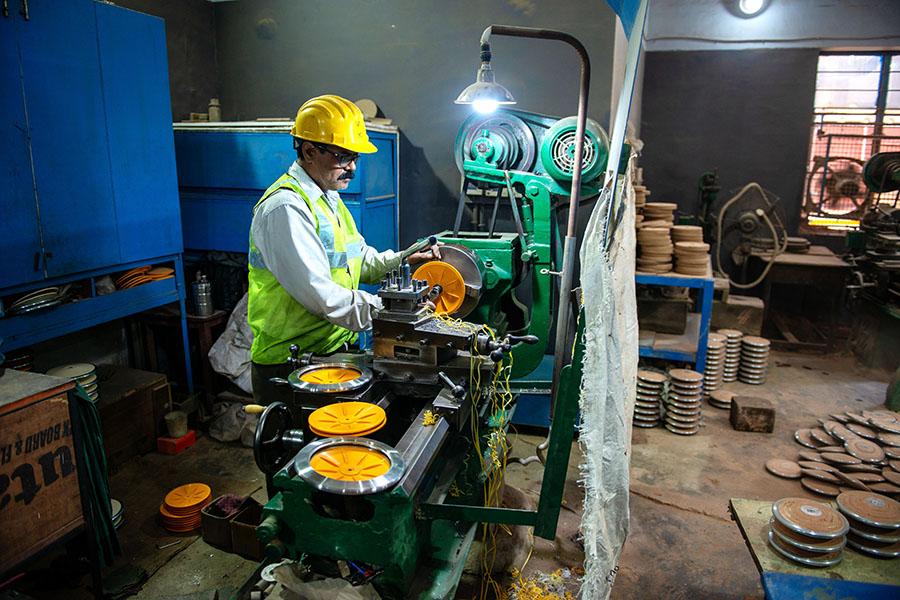[ad_1]
In their research on small businesses, JPMorgan Chase found that in 2014, over 99 percent of America’s nearly 30 million firms were small businesses. The vast majority of these employ fewer than 20 people, and nearly 40 percent of all enterprises have under $100,000 in revenue. India is not very different. On 23 March 2020, the Financial Express reported that “according to the MSME ministry’s FY19 annual report, the MSME sector is dominated by micro-enterprises. Of the 6.33 crore MSMEs, a staggering 6.3 crores (99.4 percent) are micro-enterprises”. The ‘middle’ is completely missing in India. A vast majority of them do not even have a website.
One would assume that companies, in terms of size, would follow the standard normal distribution curve, with most falling in the middle and a small number of extremes bringing up both sides of the mean. The reality is very counter-intuitive, and normal distribution is not as universal as we think. There is almost no ‘middle’. Most of the MSME companies are small, and the big ones are an insignificant minority.
If you visualise the distribution curve (number of companies versus size), you will find a large trough at the centre, a tall peak to the left of the trough, and a short peak to the right.
In his book Black Swan, Nassim Taleb argues that the distribution of book sales and city populations show a similar pattern. A few books sell really well, and sales of most books are too small to serve any purpose other than flattering the authors’ ego. A few cities grow really big, and most others remain small towns.
The Moonshot Model
The VC funding model of building companies works well for select businesses and business models but fails for most businesses. The VC model is a moonshot game where a tiny percentage of companies in the portfolio are expected to deliver exceptional returns that probably return the fund, with the rest of the companies in the portfolio just perishing. The VC funding model works at the intersection of three criteria: a large addressable market, the proposed solution or product is significantly better than the current solution or product, and a strong tailwind of technology advantage. Innovations that simultaneously fit these three criteria are unlikely to be abundant and, hence, not amenable to building and scaling via the VC model.
In his book Mass Flourishing, the Nobel Prize-winning American economist Edmund Phelps destroyed a popular myth that innovation and economic prosperity are a result of a few visionaries like Ford or Rockefeller. Based on a lifetime of research and intense reflection, he concludes that nations attain prosperity when modern values permeate deep down in society and fuel a desire among millions of people to develop new products and solve new problems. The title of the book Mass Flourishing implies the creation of both economic well-being and a greater sense of happiness (and a better quality of life) due to this mass innovation.
Middle India is a Low-Margin, Low Volume Market
Most markets have often been simplistically classified as either ‘high-margin and low-volume’ or ‘low-margin and high-volume’. However, the middle Indian markets seem a hopeless combination of ‘low-margin and low-volume’ because they are highly fragmented, geographically scattered, and further separated by cultural and language barriers.
Also Read- VCs are traders. They are not investors: Aswath Damodaran
The product value proposition, the marketing strategy, the customer acquisition cost (CAC), and the operational rigour needed to address this type of fragmented market impose constraints that are difficult to surmount and sustain within the 5-7-year timeline that VCs operate in.
Fatal Attraction
Three of the most common myths perpetuated in the VC-dominated startup world are:
a) Every business needs venture capital,
b) Growth trumps everything else, and
c) Cash burn is an investment to create discoverability and customer nudge, not an indicator of poor product-market fit.
When founders begin to believe in these myths, they tend to build businesses incorrectly. Not every business needs venture capital; not every business needs to scale exponentially or address a large market. Every business just needs to solve a real problem and be profitable. Some businesses can do this with debt, especially if their unit economics and growth trajectory can turn them cash-positive early in their journey, and some don’t need an infusion of any external capital.
In conclusion
Mood swings in the investing world are rapid, and any early sign of a new pattern is sufficient for people to swing to the other extreme. After the recent unicorn collapse and governance failures in some high-profile startups, new founders have begun to question the three common myths of the startup world.
Also Read- As easy money stops flowing startups shift their focus to profit
Many new founders emerging from India’s hinterland are beginning to take pride in how they build their businesses—frugally, profitably and sustainably in the long term.
Fortunately, some are blissfully unaware of the VC way of building businesses. VCs are an essential part of the innovation ecosystem, but the problem is when this model is used to build businesses that don’t fulfil the three criteria for this funding model to work.
The writer is the co-founder of Artha School of Entrepreneurship.
The thoughts and opinions shared here are of the author.
Check out our end of season subscription discounts with a Moneycontrol pro subscription absolutely free. Use code EOSO2021. Click here for details.
[ad_2]
Source link

